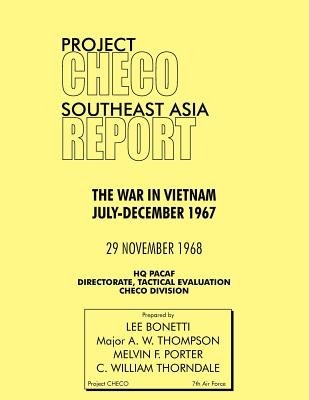
- We will send in 10–14 business days.
- Author: Lee Bonetti
- Publisher: MILITARY BOOKSHOP
- ISBN-10: 1780398212
- ISBN-13: 9781780398211
- Format: 21.6 x 27.9 x 0.9 cm, minkšti viršeliai
- Language: English
- SAVE -10% with code: EXTRA
Reviews
Description
High quality reprint of this recently declassified 1968 eport. "The War in Vietnam--July - December 1967" summarizes and provides an overall look at the Air Force role in North and South Vietnam for the semi- annual period. It is a continuation of the summary of Air Force operations first detailed in "The War in Vietnam - 1965". ROLLING THUNDER gradually increased the weight of effort against a broadening, but still limited, target complex. The high incidence of radar-directed guns and SA-2s in the extended battle area also required changes in tactics by strike and reconnaissance forces. Close air support was instrumental in breaking the enemy attacks on Dak To, Loc Ninh, and Bo Duc, often by putting ordnance within 20 feet of prepared Allied positions. Airlift units retained their basic organizational structure and successfully supported the Allied requirements at Loc Ninh and Dak To. Flying safety was the paramount problem confronting the Vietnamese Air Force (VNAF), and by August, aircraft losses due to pilot error exceeded combat losses, until finally an intensive instrument training program was initiated. The denial of crops through herbicide destruction often placed a severe strain on the enemy supply system, forcing the North Vietnamese Army (NVA) out of their normal operating areas. Enemy attacks against air bases with a steadily improving rocket capability continued to present formidable problems. Successful efforts were made during the period to substantially increase the B-52 monthly sortie rate to keep pressure on the enemy's supply and infiltration system, while at the same time blocking his efforts to mass along the DMZ.
EXTRA 10 % discount with code: EXTRA
The promotion ends in 21d.01:50:41
The discount code is valid when purchasing from 10 €. Discounts do not stack.
- Author: Lee Bonetti
- Publisher: MILITARY BOOKSHOP
- ISBN-10: 1780398212
- ISBN-13: 9781780398211
- Format: 21.6 x 27.9 x 0.9 cm, minkšti viršeliai
- Language: English English
High quality reprint of this recently declassified 1968 eport. "The War in Vietnam--July - December 1967" summarizes and provides an overall look at the Air Force role in North and South Vietnam for the semi- annual period. It is a continuation of the summary of Air Force operations first detailed in "The War in Vietnam - 1965". ROLLING THUNDER gradually increased the weight of effort against a broadening, but still limited, target complex. The high incidence of radar-directed guns and SA-2s in the extended battle area also required changes in tactics by strike and reconnaissance forces. Close air support was instrumental in breaking the enemy attacks on Dak To, Loc Ninh, and Bo Duc, often by putting ordnance within 20 feet of prepared Allied positions. Airlift units retained their basic organizational structure and successfully supported the Allied requirements at Loc Ninh and Dak To. Flying safety was the paramount problem confronting the Vietnamese Air Force (VNAF), and by August, aircraft losses due to pilot error exceeded combat losses, until finally an intensive instrument training program was initiated. The denial of crops through herbicide destruction often placed a severe strain on the enemy supply system, forcing the North Vietnamese Army (NVA) out of their normal operating areas. Enemy attacks against air bases with a steadily improving rocket capability continued to present formidable problems. Successful efforts were made during the period to substantially increase the B-52 monthly sortie rate to keep pressure on the enemy's supply and infiltration system, while at the same time blocking his efforts to mass along the DMZ.


Reviews